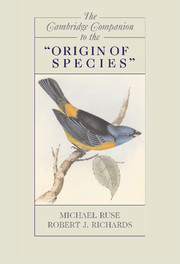Book contents
- Frontmatter
- Foreword
- Introduction
- 1 The Origin of the Origin
- 2 Darwin’s Analogy between Artificial and Natural Selection in the Origin of Species
- 3 Variation and Inheritance
- 4 Darwin’s Theory of Natural Selection and Its Moral Purpose
- 5 Originating Species: Darwin on the Species Problem
- 6 Darwin’s Keystone: The Principle of Divergence
- 7 Darwin’s Difficulties
- 8 Darwin’s Geology and Perspective on the Fossil Record
- 9 Geographical Distribution in the Origin of Species
- 10 Classification in Darwin’s Origin
- 11 Embryology and Morphology
- 12 Darwin’s Botany in the Origin of Species
- 13 The Rhetoric of the Origin of Species
- 14 “Laws impressed on matter by the Creator”? The Origin and the Question of Religion
- 15 Lineal Descendants: The Origin’s Literary Progeny
- 16 The Origin and Political Thought: From Liberalism to Marxism
- 17 The Origin and Philosophy
- 18 The Origin of Species as a Book
- Bibliography
- Index
13 - The Rhetoric of the Origin of Species
Published online by Cambridge University Press: 28 January 2009
- Frontmatter
- Foreword
- Introduction
- 1 The Origin of the Origin
- 2 Darwin’s Analogy between Artificial and Natural Selection in the Origin of Species
- 3 Variation and Inheritance
- 4 Darwin’s Theory of Natural Selection and Its Moral Purpose
- 5 Originating Species: Darwin on the Species Problem
- 6 Darwin’s Keystone: The Principle of Divergence
- 7 Darwin’s Difficulties
- 8 Darwin’s Geology and Perspective on the Fossil Record
- 9 Geographical Distribution in the Origin of Species
- 10 Classification in Darwin’s Origin
- 11 Embryology and Morphology
- 12 Darwin’s Botany in the Origin of Species
- 13 The Rhetoric of the Origin of Species
- 14 “Laws impressed on matter by the Creator”? The Origin and the Question of Religion
- 15 Lineal Descendants: The Origin’s Literary Progeny
- 16 The Origin and Political Thought: From Liberalism to Marxism
- 17 The Origin and Philosophy
- 18 The Origin of Species as a Book
- Bibliography
- Index
Summary
THE ORIGIN AS RHETORICAL ARGUMENTATION
In 1828, the Oxford don Richard Whately, having in his Elements of Logic (1826) defined argument as the connection between a claim and its support, proposed in its newly published counterpart, Elements of Rhetoric, to
treat argumentative composition as a species of rhetoric…. The office of the logician is to infer, but the office of the rhetorician is to advocate by adducing proofs…. Thus even the philosopher who undertakes by writing or speaking to convey his notion to others assumes for the time being the character of advocate of the doctrines he maintains.
(Whately 1963, 5)The idea that rhetoric is situated argumentation - argumentation giving reasons why a specific audience should come to the speaker’s side of a disputed issue or controversial topic - is old. Aristotle took this line when he defined rhetoric as the “ability to discover the available means of persuasion in each particular case” (Rhetoric I.2.1355b27-8). The idea still has champions (Toulmin 2003). This argument-centered conception of rhetoric contrasts sharply with the equally ancient view that the specific task of a rhetor is not to find or set out an argument but skillfully to deck one out with whatever ornaments of speech might induce a presumably less-than-rational audience to be affected, even infected, by it. Scientists and philosophers assume just such a conception when they hold that logically valid, context-free, undecorated arguments are the only sort that count. Whately’s view also contrasts, however, albeit less severely, with a third conception of rhetoric.
- Type
- Chapter
- Information
- The Cambridge Companion to the 'Origin of Species' , pp. 237 - 255Publisher: Cambridge University PressPrint publication year: 2008
- 5
- Cited by

